My students, postdoc, and I are having such a fun time with science, courses, and adventuring here at UTK that I’ve clearly given up trying to keep a lab blog about the great things happening here. My apologies for that, but we are having a great time and lots of success working the Late Ordovician of Tennessee (Nashville region) and comparing impacts of the Richmondian Invasion in this area vs. Cincinnati, exploring the Devonian of the Parana Basin in Brazil, checking out Great Ordovician Biodiversification Event trajectories globally, and even spending some time with Devonian trilobites.
Our lab personnel and publications pages are fully updated. So you can keep track of a little of what’s happening in those spaces.
During the 2024-25 academic year, the first two MS students graduated from the UTK Stigall Lab, Mariana Vilela-Andrade and Noel Hernandez Gomez. Mariana’s thesis was published as two papers. Noel’s is soon to be submitted for publication. Mariana and Shymah Beegum are working on their PhDs now, with Shymah just passing her qualifying exams (yay!). Kat Jordan is a post-doc working on many things, including proteid trilobite evolution. And we have a group of wonderful undergrads that have cycled through the lab over the past three years.


